Ten developments take advantage of the environmental and operational benefits of geothermal energy
Geothermal systems harness the near-constant subterranean temperature of Earth to provide buildings with reliable and efficient heating and cooling. By forgoing fossil fuels, geothermal systems help cut carbon emissions and electricity use. The underground components last for decades, requiring minimal maintenance. In addition, the systems are quiet and can boost indoor air quality. A growing number of federal, state, and municipal tax credits and incentives are available to offset upfront costs.
The following 10 projects—all built or redeveloped during the past five years—include a master-planned community constructed over a geothermal district system, a historic ropemaking facility converted into housing, a decommissioned coal power plant turned into a college recreation facility, a shoe factory transformed into a mixed-use residential development, and an aquatic center heated by an underground aquifer.
RON NYREN is a freelance architecture and urban design writer based in the San Francisco Bay area.
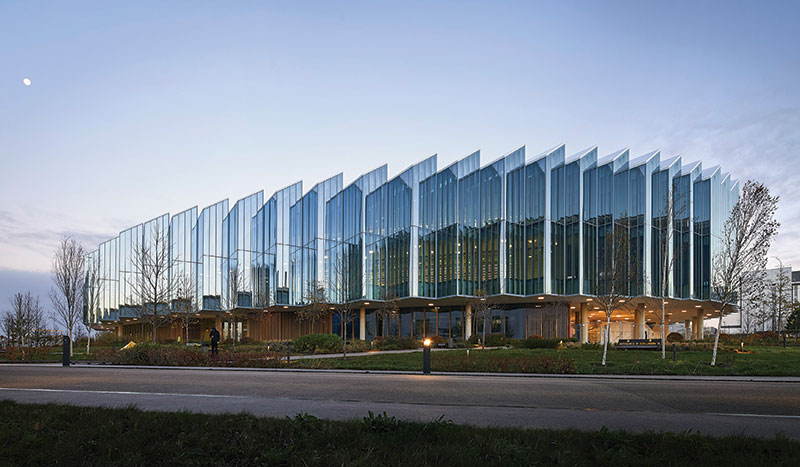
(Hufton and Crow)
1. AstraZeneca Discovery Centre
Cambridge, United Kingdom
In 2013, the biopharmaceutical company AstraZeneca held a design competition to create a new research and development center and corporate headquarters on the Cambridge Biomedical Campus. The winning architecture firm, Herzog & de Meuron of Basel, Switzerland, configured the facility as a rounded triangle bordered by the three streets that surround it. Both the roof and the façade are stepped in a sawtooth fashion and glazed, breaking up the building’s scale and letting in plenty of natural light.
The geothermal system makes use of 174 boreholes that go 650 feet (200 m) deep. They work in tandem with a ground-source heat pump and four hybrid cooling towers. The system is designed to save enough energy to power the equivalent of 2,500 homes. In addition to laboratories and workspaces for more than 2,000 scientists, the three-story building includes a conference center, an auditorium, a restaurant, and a café. The landscaped courtyard at the heart of the three-story building is open to the public. The AstraZeneca Discovery Centre opened in 2021.
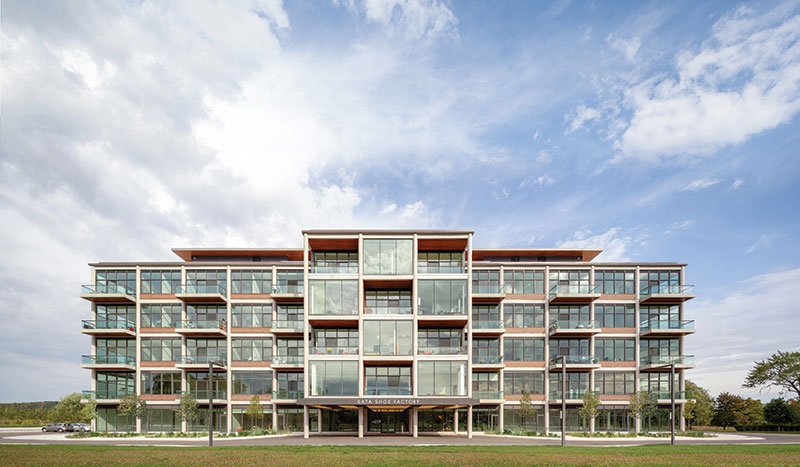
(Scott Norsworthy)
2. Bata Shoe Factory
Batawa, Ontario, Canada
Founded in the 1890s by the Bata family, Bata Shoe Company began creating company towns around its factories across the globe. In 1939, just before Germany invaded Czechoslovakia, Thomas Bata and 100 employees emigrated to set up a factory in Canada. The factory closed in 2000 and was sold, but Thomas’s widow, Sonja, bought it back in 2005 with the goal of turning it into a sustainable mixed-use development.
Architect of record BDP Quadrangle and collaborating design architects Dubbeldam Architecture + Design, both of Toronto, retained the original concrete structure, preserving 80 percent of its embodied carbon, and added wood veneer panels to lend visual warmth. Geothermal energy powers all of the heating, ventilation, and cooling systems: the landscaped parking area conceals 63 boreholes, drilled to a depth of 600 feet (180 m), beneath it. Opened in 2019, the complex includes 47 apartments, a children’s daycare facility, exhibition and community space, multipurpose rooms, educational facilities, a café, and retail space.
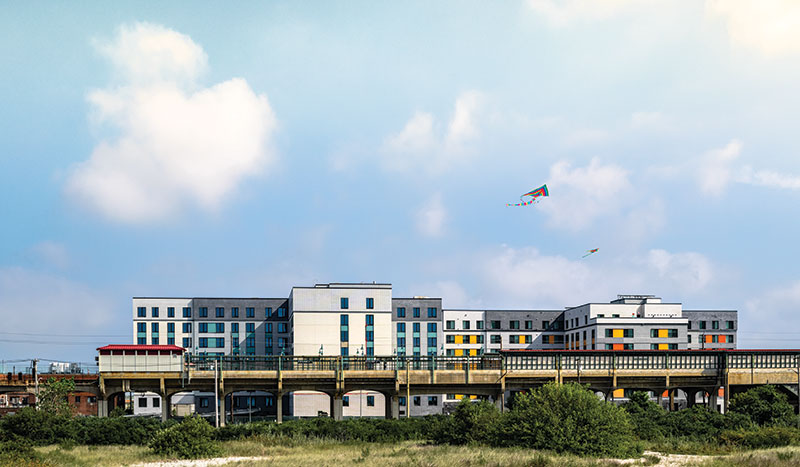
(Curtis + Ginsberg)
3. Beach Green Dunes II
Queens, New York
Rising Beach Green Dunes II is part of a larger complex of green, affordable apartment buildings, steps away from Rockaway Beach, in the Edgemere neighborhood of Queens. The 127 apartments occupy floors two through eight to protect them from coastal flooding. All units are affordable to households with incomes that do not exceed 100 percent of area median income. Opened in 2020, the building also includes shops and outdoor recreation areas.
A closed-loop geothermal system, tucked beneath surface parking and a bioswale, is designed to meet all of the building’s heating and cooling needs. Each apartment has a heat pump connected to the geothermal system, providing heating and cooling with individual temperature control. With the help of a tight building envelope, photovoltaic panels, and a centralized energy recovery ventilation system, the setup enabled Beach Green Dunes II to achieve Passive House certification. Curtis + Ginsberg Architects of New York City designed the building for L+M Development Partners of Larchmont, New York, and Triangle Equities of Whitestone, New York.
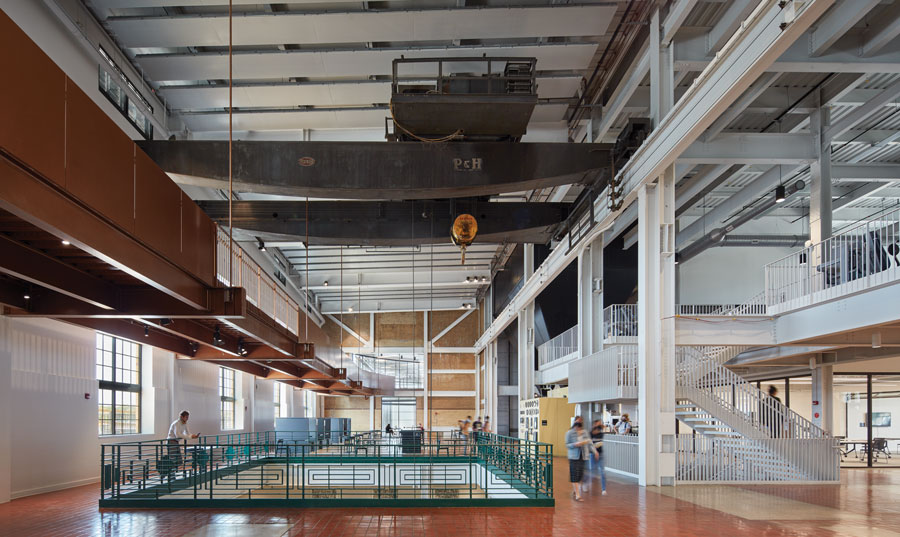
(Tom Harris Courtesy Studio Gang)
4. Beloit College Powerhouse
Beloit, Wisconsin
A former coal power plant dating back to the early 1900s has found new life as the Powerhouse, a student union, recreation center, and athletic facility for Beloit College. A new pedestrian bridge, new parks, and new pathways reconnect the campus and nearby downtown to the Rock River, which also serves as a geothermal source of efficient heating and cooling for the building. Water is piped in through a heat exchanger that, along with radiant panels, modulates interior temperatures.
Designed by Chicago-based Studio Gang with associate architect Angus-Young Associates of Madison and Janesville, Wisconsin, the renovated building includes an auditorium, a conference center, student lounges, and a coffee shop. To embody the building’s past, the architects retained old equipment and infrastructure, some of which supports an elevated running track that circulates through the whole facility. The field house addition has a polycarbonate façade that lets in diffuse natural light. The Powerhouse opened in 2020.
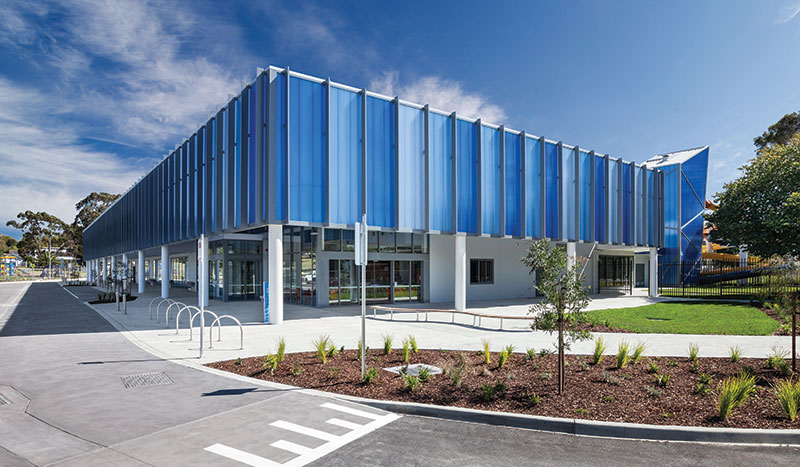
(Chris Matteson Photography)
5. Gippsland Regional Aquatic Centre
Traralgon, Victoria, Australia
The Latrobe Valley in the Gippsland region of Victoria has long been a center for the mining and burning of coal, which supplies most of the state’s electricity. But when the time came to construct a new public aquatic facility, the Latrobe City Council chose to tap a cleaner and even longer-standing source of energy in the area: vast aquifers beneath the valley, which maintain a temperature of 150 degrees Fahrenheit (65 degrees C). Designed by the Melbourne office of Peddle Thorp, the Gippsland Regional Aquatic Centre incorporates a closed-loop deep-bore geothermal heating system that taps into the aquifers and saves $640,000 per year (US$430,000) in heating costs.
Completed in 2021, the facility includes an eight-lane, 50-meter indoor pool with seating for 500 spectators, an indoor water play zone, a warm-water pool, spa and sauna areas, a wellness center, a café and retail area, and changing facilities. Funding came, in part, from the Victoria government.
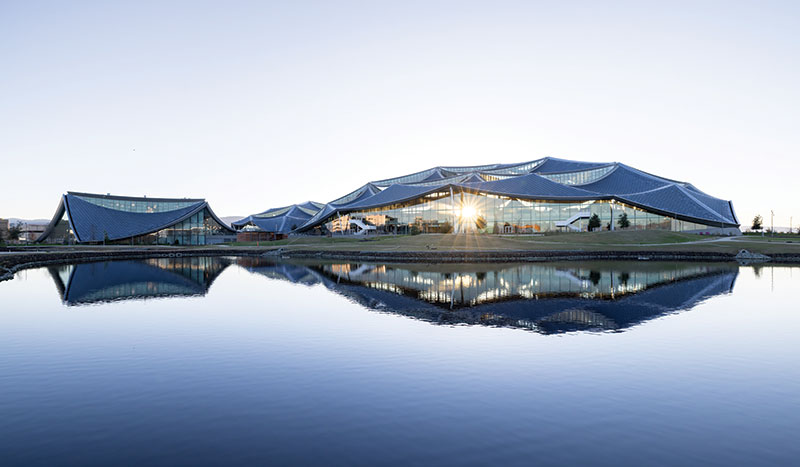
(Iwan Baan)
6. Google Bay View Campus
Mountain View, California
If the hundred miles of pipes in the geothermal system of Google’s new headquarters were laid end to end, they would stretch, approximately, from Mountain View to Sacramento. The closed-loop pipe system is integrated with the building’s 4,000 structural piles, drawing heat from the ground in cold months and storing heat in the earth during warm periods. Estimated to cut carbon emissions nearly in half and reduce water consumption required for cooling by 90 percent, it is billed as the largest geothermal pile system in North America.
Copenhagen-based BIG and London-based Heatherwick Studio designed the 42-acre (17 ha) campus with Google’s design and engineering teams. Completed in 2022, the headquarters has room for 4,000 employees and includes office space and an event center. It is also 100 percent electric, powered by interlocking rooftop solar panels and energy generated by nearby wind farms. The campus includes bay view trails accessible to the public, as well as woodlands, marshlands, and wet meadows.
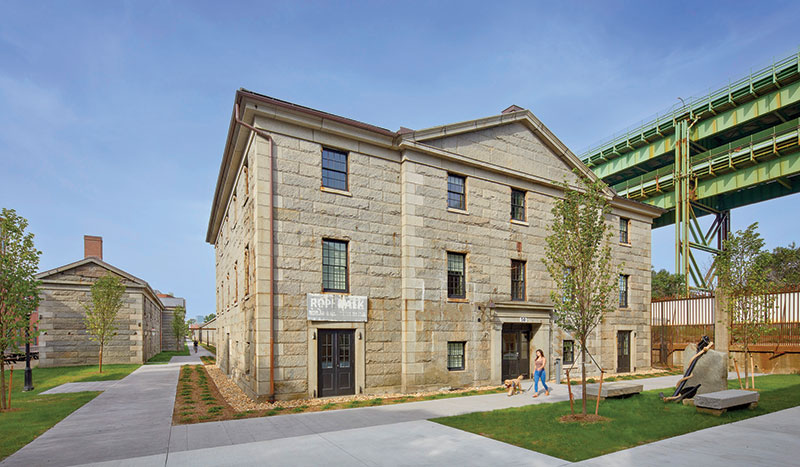
(Bruce Martin courtesy The Architectural Team)
7. Ropewalk
查尔斯顿,马ssachusetts
建筑在查尔斯镇海军院子里的一个s historic 1838 ropemaking complex stretches a quarter mile, its length outmatching the Empire State Building’s height. Here, ropemakers once laid out fibers and twisted them together. Listed on the National Register of Historic Places, the facility shuttered in the 1970s and remained vacant and deteriorating until the Boston Planning and Development authority, working with the National Park Service, engaged Tampa-based Vision Properties to convert the complex into mixed-income housing.
Completed in 2021, the 97 units range from studios to three-bedroom apartments and retain historical elements such as exposed timber beams. One quarter of the units is earmarked as affordable for low-income households. Six closed geothermal loops supply heating and cooling, with each unit having its own individual temperature controls. Designed by the Architectural Team of Chelsea, Massachusetts, Ropewalk also includes exhibition space displaying historical ropemaking equipment.
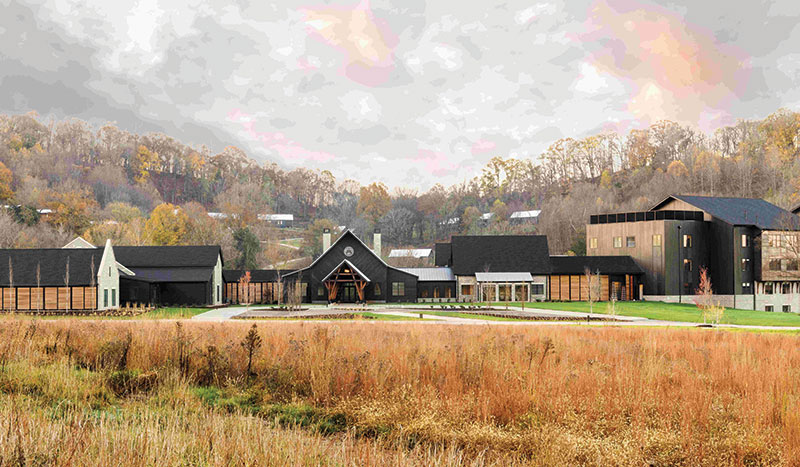
(Courtesy of Southall)
8. Southall
Franklin, Tennessee
Southall founder Paul Mishkin chose sustainability as the guiding principle in creating a luxury farm resort 25 miles (40 km) south of downtown Nashville. Local firm 906 Studio Architects + Interiors designed four interconnected buildings with cross-laminated timber, heavy timber, and conventional wood framing, all from managed forests, and oriented the structures to take advantage of natural light. Rooftop photovoltaic panels generate electricity. Underneath the parking lot, McHugh Construction drilled 110 geothermal wells 400 feet (122 m) deep to provide heating and cooling, as well as hot water for guestrooms, the spa, and the kitchen. Smart technology further reduces energy use in unoccupied spaces.
The working farm includes an apple orchard, greenhouses, a farm stand, row crops and kitchen gardens, and apiaries that host 4 million honey-producing bees. Rainwater collected from roofs and gutters flows into the artificially formed Lake Mishkin for irrigation, and meets almost all the watering needs for the crops and landscape. Opened in 2022, Southall includes 62 guestrooms, 16 cottages, restaurants, and an executive boardroom.
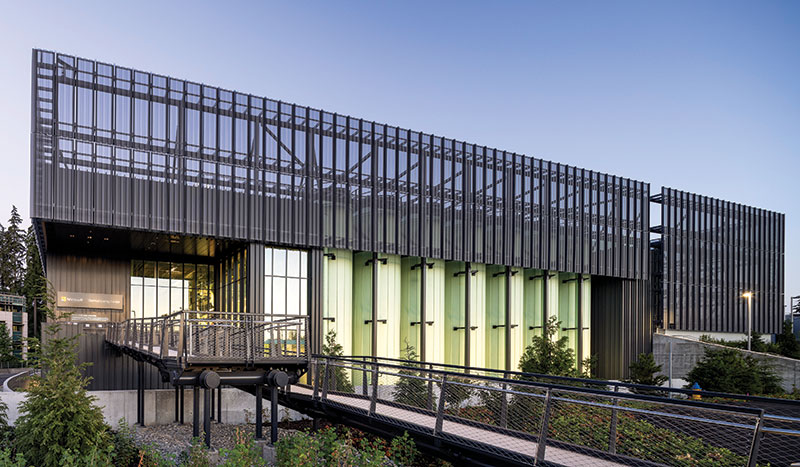
(NBBJ/Sean Airhart)
9. Thermal Energy Center
Redmond, Washington
As part of the modernization of its corporate campus on the outskirts of Seattle, Microsoft decided to make the 17 new buildings all electric as part of its goal to become carbon negative by 2030. In addition to drilling 875 geowells to a depth of 550 feet (168 m), the company tasked the Seattle office of NBBJ with designing the Thermal Energy Center at the heart of the campus to contain the geothermal system’s chillers, cooling towers, back-up generators, and 65-foot-high (20 m) tanks, which can contain 280,000 gallons (1,060 kl) of water to hold thermal energy.
Storing water rather than expelling it, as conventional cooling towers do, is estimated to cut water consumption by 8 million gallons (30,300 kl) each year. To make the geothermal technology visible to employees, visitors, and the public, extensive glazing showcases the equipment inside the three-story building. A pedestrian bridge makes it easy for visitors to approach the facility and view its interior. Completed in 2022, the Thermal Energy Center has rooftop photovoltaic panels that generate additional electricity.
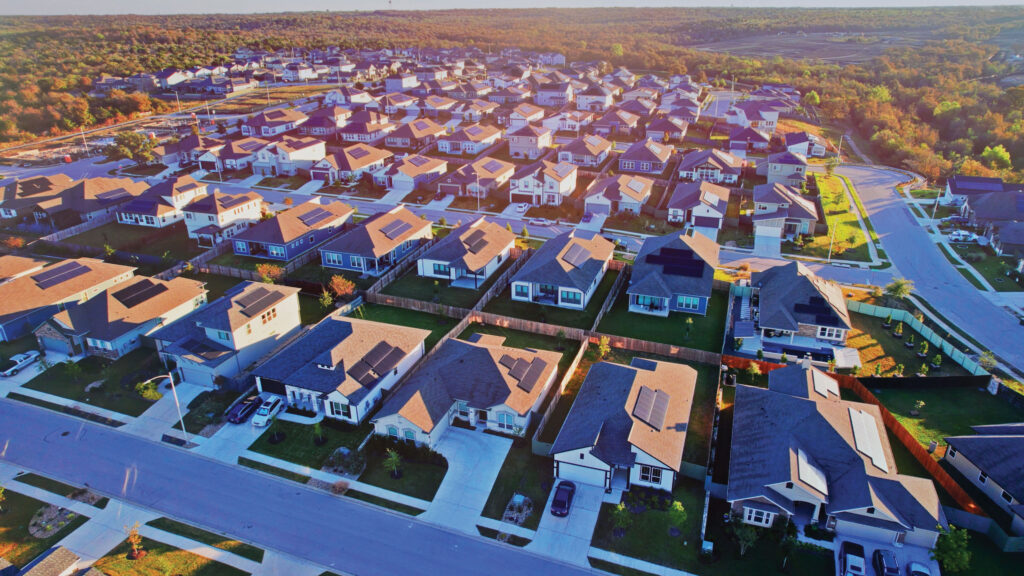
(Taurus Investment Holdings, LLC)
10. Whisper Valley
Austin, Texas
当冬天的风暴在2021年2月带来了好多e cold temperatures to Texas, the state’s power grid failed, and 4.5 million homes and businesses lost electricity and heating. The residents of Whisper Valley, however, kept warm thanks to an extensive geothermal system installed beneath the master-planned community before any of its buildings were constructed. With 2,067 acres (840 ha) slated to include 7,500 single and multifamily homes and apartments, two million square feet (186,000 sq m) of commercial space, two schools, and a 600-acre (240 ha) park, it is billed as the largest geothermal-powered residential community in the United States.
Owner and developer Taurus Investment Holdings, headquartered in Boston, requires all builders in Whisper Valley to connect houses to its “GeoGrid,” created by its affiliate EcoSmart Solution. Houses also have rooftop solar panels and a real-time energy monitoring system so residents can track their electricity usage. Buyers can finance the geothermal system and other sustainability measures into their mortgage to spread out the costs. As of 2022, 868 lots have been completed over four phases. UL

